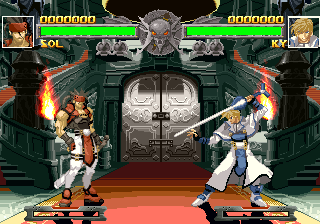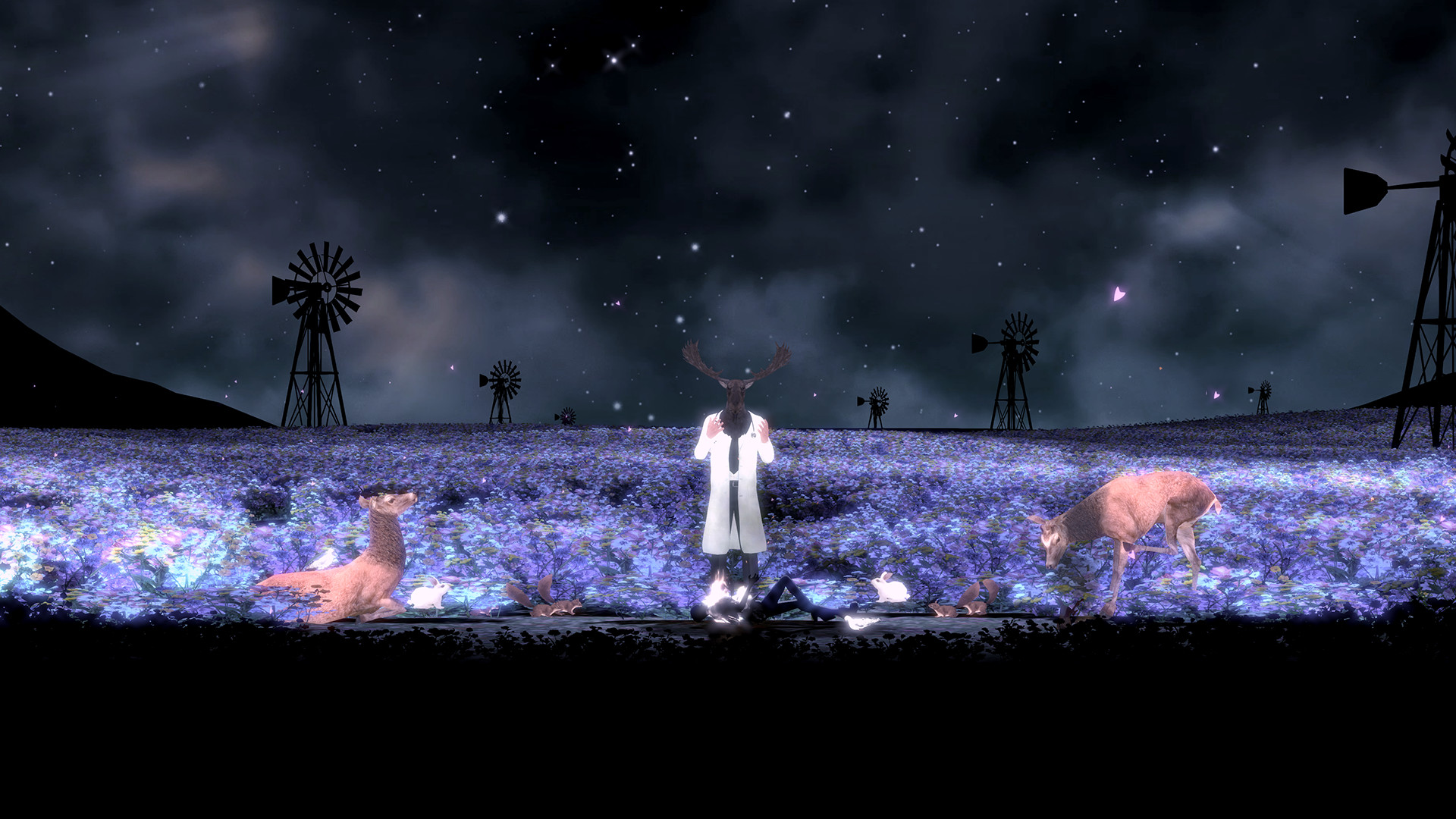Guilty Gear came out for the PlayStation in 1998, first in Japan and then in the U.S. a few months later. Critics praised its “unrivaled animation quality” and “kick-ass aural experience.” But while the first game was a good foundation for the series and earned a small following of hardcore fans, it didn’t take off as much as later entries would. Some people, Kidooka recalled, were wondering why Arc was still making 2D games when seemingly every developer was moving into 3D.

Above: The first Guilty Gear for the PlayStation.
With support from publisher Sammy (now known as Sega Sammy), Ishiwatari and his team moved on to make the sequel, Guilty Gear X. Originally released in Japanese arcades in 2000, ports of GGX eventually came out for Dreamcast, PlayStation 2, PC, and even Game Boy Advance.
“[GGX] really put us on the map and showed that, hey, we can make a good fighting game,” said Kidooka.
Guilty Gear became Arc System Works’ signature franchise, leading to a plethora of updates, spinoffs, and sequels in the years since GGX’s debut. In that time, it developed a reputation for being a pretty series, yet one that’s difficult to get into due to increasingly difficult gameplay mechanics and concepts. The developer also continued to work on other fighting games, including Sengoku Basara X (a spinoff of the Capcom action series) and Fist of the North Star (also based on an anime).
But in the mid-2000s, with the imminent arrival of a new generation of consoles, Arc decided that it was time to create its next original property.
“We did everything we could with the Guilty Gear franchise at the time; the last one that we worked on was [Guilty Gear XX] Accent Core. With every upgrade, every change we made, the game became more and more of a niche title,” said Kidooka. “The community and the fan pool got smaller and smaller with each upgrade. And the barrier to entry became higher for new players to join.
“The PlayStation 3 was coming around, and everything was becoming HD. … And that was when we realized we needed to take advantage of the next-gen consoles and their power.”
Going beyond fighting games
This time, Kidooka turned to Toshimichi Mori for ideas. The designer had been working at the company for a few years, helping out on games like Accent Core and Guilty Gear Isuka. Coincidentally, he also studied at Amusement Media for game design — but mostly because a Japanese idol he admired would occasionally give lectures there.
That’s where he first met Ishiwatari, who was one grade above him. It was the beginning of a lifelong friendship that, at times, can resemble more of a rivalry (especially once their respective franchises took off).
The timing for Arc’s new project couldn’t have been better for Mori, as the team that was working on Guilty Gear XX Slash were free to move on to something else. Together, they set out to make a high-definition 2D fighter that would be easier to get into than the studio’s previous games.
“I thought the Guilty Gear franchise became too difficult as a game,” said the 46-year-old Mori. “I wanted to simplify a lot of it, to kind of reset the fighting game platform.”
That philosophy led to the creation of BlazBlue: Calamity Trigger, which came out in arcades before heading to PlayStation 3 and Xbox 360 in 2009. In addition to having a simpler control scheme, the game built on Guilty Gear’s legacy by combining gorgeous 2D animations with off-the-wall characters and flashy combos.

Above: BlazBlue: Calamity Trigger was Arc’s first HD fighting game.
While BlazBlue would also wind up having several sequels and iterations (and like Guilty Gear before it, added complicated move sets and techniques), Mori had much bigger aspirations for it beyond just video games.
“Instead of thinking of it as just a fighting game, I wanted to turn it into a single piece of content, an [intellectual property]. And that way, we can deploy it through many different mediums because we have a lot of cool characters here,” he said. “Fighting games were still a very niche genre back then, so it really needed to have its own identity where it would be able to translate to multiple mediums aside from just a fighting game.”
Shortly after Calamity Trigger’s release, BlazBlue plot lines and characters started popping up in other forms of media, including manga and anime. This broader type of thinking wasn’t limited to Mori’s series, however. In 2007, Arc System Works was in the process of becoming a publisher as well. At this point, the studio had 50 employees, and Mori said they were having a lot of discussions about how they should sell and market their games.
They also started hosting their own gatherings for the press, like they did in Shibuya with Japanese actress Kaori Manabe for the launch of the PlayStation Portable game Guilty Gear Judgment.
“We started doing a lot of exploring, including having our own events and trying new and different things we wouldn’t normally have done if we were just developers,” said Mori.
Everyone was so busy with development and publishing that Arc’s 20th anniversary in 2008 passed without much celebration (it rectified that in 2013 with Arc Fes, a party held in Yokohama with 6000 fans). But the late 2000s was an important moment for the studio, as it was only then that the developers felt like they were starting to cultivate their own identity.
“Instead of being this weird developer-publisher hybrid, we focused on [being] a publisher who can also develop in-house,” said Kidooka. “BlazBlue and Guilty Gear became the pillars for us, enabling us to find that Arc brand of publishing.”
The company’s publishing slate has since become an eclectic mix of studios and genres. Most recently, it released The Missing: J.J. Macfield and the Island of Memories, a puzzle-platformer from famed Japanese developer Hidetaka “Swery” Suehiro; and anime fighter Under Night In-Birth Exe: Latest from indie studio French Bread.

Above: The Missing is a collaboration between Arc and Swery’s White Owls studio.
Embracing their big moment
The only thing Arc was missing was a rock anthem.
But Kidooka could’ve never predicted the elaborate music video they’d film for their 30th anniversary. He just thought it’d be fun to have an official song that represented Arc System Works, a common practice among companies in Japan. He said their idea for the anthem “started to transform and take its own shape,” especially after an employee suggested that they should also make a music video. Naturally, it was Ishiwatari who composed the catchy tune.
While the developers had a lot of fun preparing for their performance, Mori — who fights against one of his BlazBlue characters in the video and loses — is still a bit miffed that the hardest part of their choreography ended up on the cutting room floor. The fans seem to appreciate their effort; during a party at the Evo 2018 fighting game tournament in Las Vegas, Kidooka and other staff members performed their dance in front of a raucous crowd.

